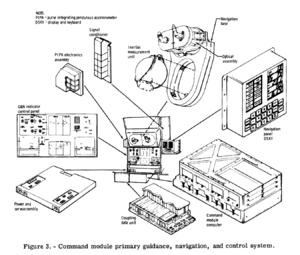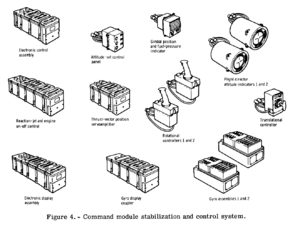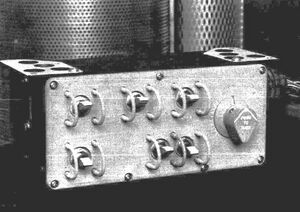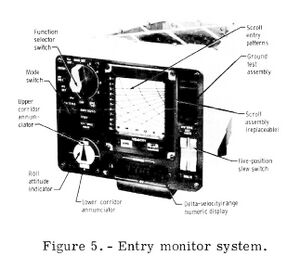Guidance and Control System: Difference between revisions
imported>Tschachim m (Fixed link) |
imported>Tschachim m (→Primary Guidance, Navigation and Control System (PGNCS): link to IMU) |
||
| Line 11: | Line 11: | ||
Guidance and navigation were two of the most important tasks in the Apollo spacecraft, with a large amount of hardware dedicated to those tasks; in order to get to the Moon and back, the astronauts needed to know where they were and how to get to where they wanted to be. | Guidance and navigation were two of the most important tasks in the Apollo spacecraft, with a large amount of hardware dedicated to those tasks; in order to get to the Moon and back, the astronauts needed to know where they were and how to get to where they wanted to be. | ||
The Inertial Measurement Unit fed information about acceleration and rotation to the Apollo Guidance Computer, and the Optics system was used to fine-tune the computer's attitude information on a regular basis. Interaction between the astronauts and the AGC was primarily through the [[Display and Keyboard Assembly]] interface which allowed the AGC to display information and the astronauts to enter new values. | The [[Inertial Measurement Unit]] fed information about acceleration and rotation to the Apollo Guidance Computer, and the Optics system was used to fine-tune the computer's attitude information on a regular basis. Interaction between the astronauts and the AGC was primarily through the [[Display and Keyboard Assembly]] interface which allowed the AGC to display information and the astronauts to enter new values. | ||
===See Also=== | ===See Also=== | ||
Revision as of 20:12, 4 February 2007

The Guidance and Control System consisted of a number of sub-systems for in-flight navigation and guidance.
This article gives a high-level overview of the sub-systems: detailed information use will be on individual pages for those systems.

Guidance and navigation were two of the most important tasks in the Apollo spacecraft, with a large amount of hardware dedicated to those tasks; in order to get to the Moon and back, the astronauts needed to know where they were and how to get to where they wanted to be.
The Inertial Measurement Unit fed information about acceleration and rotation to the Apollo Guidance Computer, and the Optics system was used to fine-tune the computer's attitude information on a regular basis. Interaction between the astronauts and the AGC was primarily through the Display and Keyboard Assembly interface which allowed the AGC to display information and the astronauts to enter new values.
See Also
Stabilisation and Control System (SCS)

|{{#if:|, | and }}[[{{{2}}}|{{{2}}}]]}}{{#if:
|{{#if:|, |, and }}[[{{{3}}}|{{{3}}}]]}}{{#if:
|{{#if:|, |, and }}[[{{{4}}}|{{{4}}}]]}}{{#if:
|, and [[{{{5}}}|{{{5}}}]]}}{{#if: | (too many parameters in {{mainarticle}})}}
The Stabilization and Control System (SCS) provides a capability for monitoring and controlling the attitude of the spacecraft, for translational manoeuvers and SPS thrust vector control. Also the SCS is the backup system for the Primary Guidance, Navigation and Control System (PGNCS).
Orbital Rate Display Earth And Lunar

|{{#if:|, | and }}[[{{{2}}}|{{{2}}}]]}}{{#if:
|{{#if:|, |, and }}[[{{{3}}}|{{{3}}}]]}}{{#if:
|{{#if:|, |, and }}[[{{{4}}}|{{{4}}}]]}}{{#if:
|, and [[{{{5}}}|{{{5}}}]]}}{{#if: | (too many parameters in {{mainarticle}})}}
In normal use the Flight Director Attitude Indicator displays would show the inertial attitude relative to distant stars. This was useful in free space, but when in orbit the pilot may want to see the spacecraft's attitude relative to the surface of the Earth or Moon.
The Orbital Rate Display Earth And Lunar (ORDEAL) was a simple system which could be configured to rotate the FDAIs appropriately so that they would display the attitude relative to the surface instead. Configuration is also simple, with a switch for Earth or Moon and an altitude selector, and the orbital rates are calculated automatically from these settings.
Entry Monitoring System

|{{#if:|, | and }}[[{{{2}}}|{{{2}}}]]}}{{#if:
|{{#if:|, |, and }}[[{{{3}}}|{{{3}}}]]}}{{#if:
|{{#if:|, |, and }}[[{{{4}}}|{{{4}}}]]}}{{#if:
|, and [[{{{5}}}|{{{5}}}]]}}{{#if: | (too many parameters in {{mainarticle}})}}
The Entry Monitoring System is used by the crew to monitor the entry trajectory flown by the PGNCS and allows the pilot to fly a manual re-entry if required.
The main EMS panel includes a velocity/load-factor display, range-to-go display, 0.05g indicator and roll/attitude indicator.
External Links
- Apollo experience report: Command and service module reaction control systems
- Apollo experience report: Guidance and control systems
- Apollo experience report: Guidance and control systems - Digital autopilot design development
- Apollo experience report: Lunar module landing radar and rendezvous radar
- Apollo experience report: Lunar module reaction control system
- Apollo Training: Guidance and Control Systems